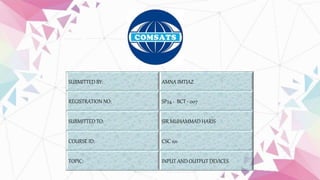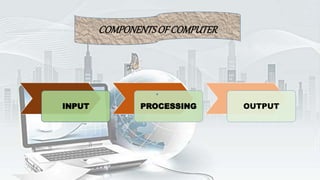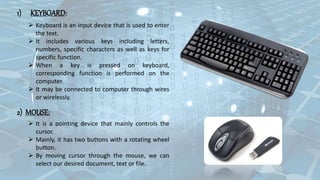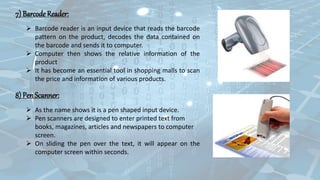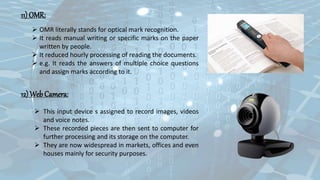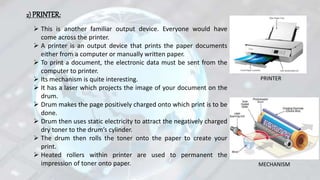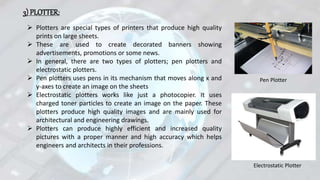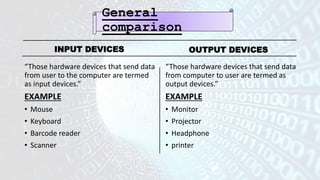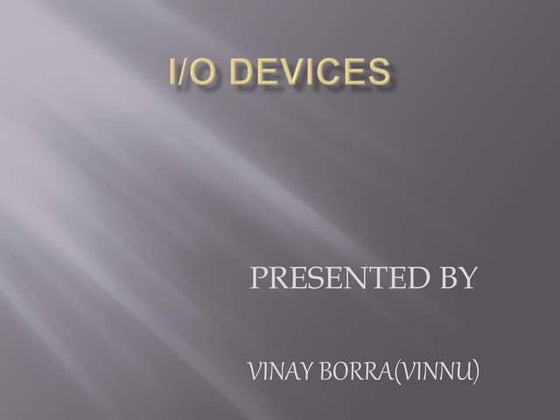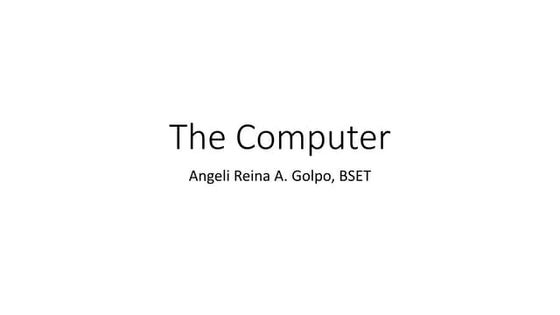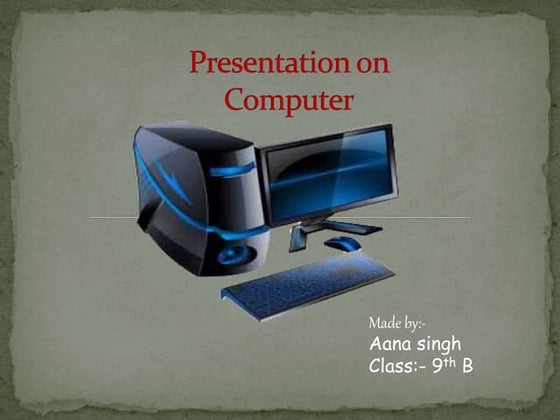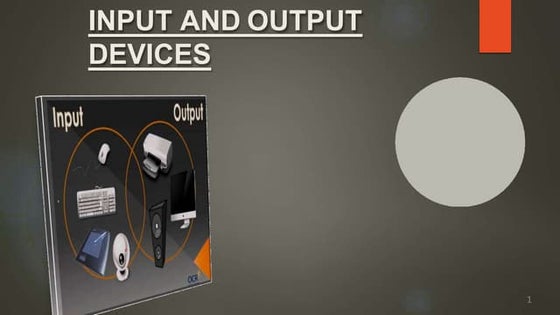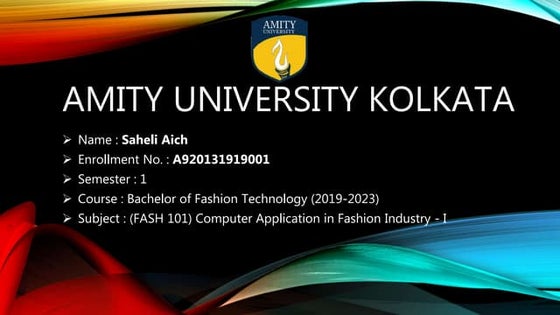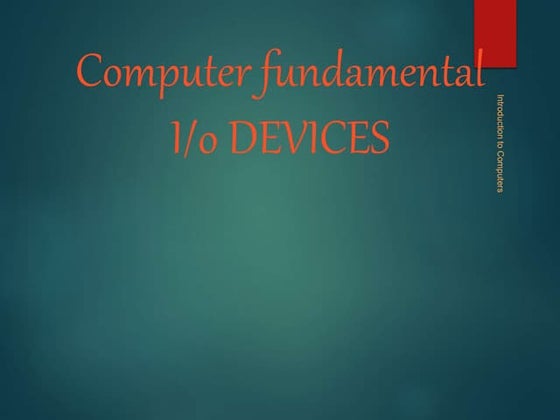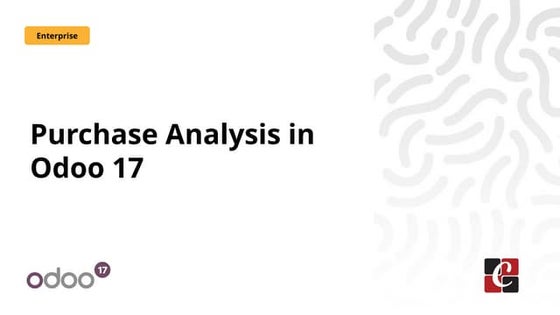Presentation ICT 11.pptx. A detailed note on Input and Output devices by using examples and explaining their mechanism
- 1. SUBMITTED BY: AMNA IMTIAZ REGISTRATION NO: SP24 - BCT - 007 SUBMITTED TO: SIR MUHAMMAD HARIS COURSE ID: CSC 101 TOPIC: INPUT AND OUTPUT DEVICES
- 2. COMPONENTSOF COMPUTER INPUT PROCESSING OUTPUT
- 3. INPUT DEVICES ’ü▒ Keyboard ’ü▒ Mouse ’ü▒ Joystick ’ü▒ Light Pens ’ü▒ Track Ball ’ü▒ Web Camera ŌĆ£Those hardware devices which take data from user and send it to computer are termed as hardware devicesŌĆØ EXAMPLE ’ü▒ Scanner ’ü▒ Passport Scanner ’ü▒ Pen Scanners ’ü▒ Barcode Reader ’ü▒ OMR ’ü▒ Graphic Tablets
- 4. 1) KEYBOARD: ’āś Keyboard is an input device that is used to enter the text. ’āś It includes various keys including letters, numbers, specific characters as well as keys for specific function. ’āś When a key is pressed on keyboard, corresponding function is performed on the computer. ’āś It may be connected to computer through wires or wirelessly. 2) MOUSE: ’āś It is a pointing device that mainly controls the cursor. ’āś Mainly, it has two buttons with a rotating wheel button. ’āś By moving cursor through the mouse, we can select our desired document, text or file.
- 5. 3) Joystick: ’āś Joystick is an input device primarily used to control digital entities in games. ’āś You might have seen these in kids play zone. ’āś Typically, it consists of a lever like a gear that can be rotated in any direction to control the movement of particular object in gaming. 4) Light Pens: ’āś It is a light sensitive pointing device used with old CRT monitors. ’āś It is basically used to select, modify or scan the text or images on the screen. ’āś It may also be used to draw images, figures or to enter the text.
- 6. 5) Trackball: ’āś Trackball is pointing device that is almost similar to mouse used in computer gaming. ’āś Unlike mouse, you donŌĆÖt need to move the entire device. ’āś It has movable ball on its top so that you can manage and control various moving objects in computer gaming. 6) Scanner: ’āś Scanner converts physical documents like images, graphics and texts into digital format ’āś In simple words, it is a digital photocopier which reads handwritten or manual documents. ’āś Most commonly, it is used in offices to scan various documents.
- 7. 7) Barcode Reader: ’āś Barcode reader is an input device that reads the barcode pattern on the product, decodes the data contained on the barcode and sends it to computer. ’āś Computer then shows the relative information of the product ’āś It has become an essential tool in shopping malls to scan the price and information of various products. 8) PenScanner: ’āś As the name shows it is a pen shaped input device. ’āś Pen scanners are designed to enter printed text from books, magazines, articles and newspapers to computer screen. ’āś On sliding the pen over the text, it will appear on the computer screen within seconds.
- 8. 9) Graphic Tablet: ’āś Graphics tablet is an input device that aided the painters and graphic designers in their profession. ’āś Graphics tablet allows user to draw images by hand on the tablet with a special pen like stylus. ’āś The drawn image or written text then appears on computer screen. 10) Passport Scanner: ’āś Passport scanners are designed for quick scanning of passports, ID-cards, resident permits and driving license. ’āś Most commonly, you see passport scanners on airports, international hostel checks and security posts.
- 9. 11) OMR: ’āś OMR literally stands for optical mark recognition. ’āś It reads manual writing or specific marks on the paper written by people. ’āś It reduced hourly processing of reading the documents. ’āś e.g. It reads the answers of multiple choice questions and assign marks according to it. 12) Web Camera: ’āś This input device s assigned to record images, videos and voice notes. ’āś These recorded pieces are then sent to computer for further processing and its storage on the computer. ’āś They are now widespread in markets, offices and even houses mainly for security purposes.
- 10. OUTPUT DEVICES ŌĆ£Those hardware devices that receive information from computer and sends to viewer are called as output devices.ŌĆØ They receive processed data from computer and transform into audio, video or text. EXAMPLE: ŌĆó Monitor ŌĆó Printer ŌĆó Projector ŌĆó Headphones ŌĆó Speaker
- 11. 1) MONITOR: ’āś A display screen that provides visual output from computer is termed as monitor. ’āś Old CRT monitors and LCD are its common examples. ’āś CRT stands for cathode ray tube while LCD stands for liquid crystal display. ’āś Major difference between CRT and LCD is the technology of their image formation. ’āś CRT monitors uses electro beam to display an image. ’āś While LCD produces an image on the screen by using liquid crystal display. ’āś CRT monitors occupy more space and processing time as compared to LCDs. ’āś With the advancement in technology, LEDs are now in more practice as compared to LCDs ’āś LED stands for light emitting diode that use light emitting diode in its functioning. MONITOR LCD LED
- 12. 2) PRINTER: ’āś This is another familiar output device. Everyone would have come across the printer. ’āś A printer is an output device that prints the paper documents either from a computer or manually written paper. ’āś To print a document, the electronic data must be sent from the computer to printer. ’āś Its mechanism is quite interesting. ’āś It has a laser which projects the image of your document on the drum. ’āś Drum makes the page positively charged onto which print is to be done. ’āś Drum then uses static electricity to attract the negatively charged dry toner to the drumŌĆÖs cylinder. ’āś The drum then rolls the toner onto the paper to create your print. ’āś Heated rollers within printer are used to permanent the impression of toner onto paper. PRINTER MECHANISM
- 13. 3) PLOTTER: ’āś Plotters are special types of printers that produce high quality prints on large sheets. ’āś These are used to create decorated banners showing advertisements, promotions or some news. ’āś In general, there are two types of plotters; pen plotters and electrostatic plotters. ’āś Pen plotters uses pens in its mechanism that moves along x and y-axes to create an image on the sheets ’āś Electrostatic plotters works like just a photocopier. It uses charged toner particles to create an image on the paper. These plotters produce high quality images and are mainly used for architectural and engineering drawings. ’āś Plotters can produce highly efficient and increased quality pictures with a proper manner and high accuracy which helps engineers and architects in their professions. Electrostatic Plotter Pen Plotter
- 14. 4) PROJECTOR: ’āś You must be familiar of projector which are installed in seminars, cinemas, conference halls and in classes. ’āś These video projector displays video, images, text or presentations on a larger screen or other flat surface. ’āś These are commonly used in offices for business meetings, for educational purposes in classed and for entertainment in cinemas. ’āś Projector working involves splitting the beam of light primarily into three colors; red, blue and green. ’āś The split light then passes through various filters. ’āś This filtered light is then fall on the prism and shown onto a larger screen through lens. ’āś Projectors attract the attention of viewers within seconds through its larger screen surface. ’āś Moreover, projector provides comfort to our eyes Projector
- 15. 5) HEADPHONE: ’āś Headphones are output devices that consist of pair of small speakers plug into a computer line or to speakers. ’āś Headphones are also known as earphones. ’āś They are used for listening sound from a computer, music player or other such electronic device. ’āś They turn the electrical energy into sound by using magnets to vibrate the air, which then creates sound. ’āś Digital audio is stored in the form of 0ŌĆÖs and 1ŌĆÖs; ’āś Headphones allows user listen to an audio note privately, in contrast to loud speaker, which emits sound into open atmosphere for everyone nearby to hear. ’āś Headphones are most commonly used in musical industries and music production sites. ’āś They allow the user to listen a particular note ignoring the surrounding noise. Headphone
- 16. General comparison INPUT DEVICES ŌĆ£Those hardware devices that send data from user to the computer are termed as input devices.ŌĆØ EXAMPLE ŌĆó Mouse ŌĆó Keyboard ŌĆó Barcode reader ŌĆó Scanner OUTPUT DEVICES ŌĆ£Those hardware devices that send data from computer to user are termed as output devices.ŌĆØ EXAMPLE ŌĆó Monitor ŌĆó Projector ŌĆó Headphone ŌĆó printer
